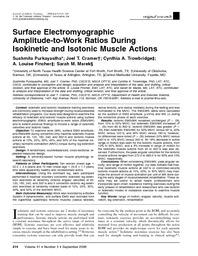| dc.description.abstract | Context: Isokinetic and isotonic resistance training exercises
are commonly used to increase strength during musculoskeletal
rehabilitation programs. Our study was designed to examine the
efficacy of isokinetic and isotonic muscle actions using surface
electromyographic (EMG) amplitude-to-work ratios (EMG/WK)
and to extend previous findings to include a range of isokinetic
velocities and isotonic loads.
Objective: To examine work (WK), surface EMG amplitude,
and EMG/WK during concentric-only maximal isokinetic muscle
actions at 60, 120, 180, 240, and 300/s and isotonic muscle
actions at 10%, 20%, 30%, 40%, and 50% of the maximal voluntary isometric contraction (MVIC) torque during leg extension
exercises.
Design: A randomized, counterbalanced, cross-sectional, repeated-measures design.
Setting: A university-based human muscle physiology research laboratory.
Patients or Other Participants: Ten women (mean age
22.0 2.6 years) and 10 men (mean age 20.8 1.7 years)
who were apparently healthy and recreationally active.
Intervention(s): Using the dominant leg, each participant
performed 5 maximal voluntary concentric isokinetic leg extension exercises at randomly ordered angular velocities of 60,
120, 180, 240, and 300/s and 5 concentric isotonic leg extension exercises at randomly ordered loads of 10%, 20%, 30%,
40%, and 50% of the isometric MVIC.
Main Outcome Measure(s): Work was recorded by a Biodex
System 3 dynamometer, and surface EMG was recorded from
the superficial quadriceps femoris muscles (vastus lateralis,
rectus femoris, and vastus medialis) during the testing and was
normalized to the MVIC. The EMG/WK ratios were calculated
as the quotient of EMG amplitude ( Vrms) and WK (J) during
the concentric phase of each exercise.
Results: Isotonic EMG/WK remained unchanged (P .05)
from 10% to 50% MVIC, but isokinetic EMG/WK increased (P
.05) from 60 to 300/s. Isotonic EMG/WK was greater (P
.05) than isokinetic EMG/WK for 50% MVIC versus 60/s, 40%
MVIC versus 120/s, and 30% MVIC versus 180/s; however,
no differences were noted (P .05) between 20% MVIC versus
240/s or 10% MVIC versus 300/s. An 18% decrease in active
range of motion was seen for the isotonic muscle actions, from
10% to 50% MVIC, and a 3% increase in range of motion for
the isokinetic muscle actions from 60 to 300/s was also observed. Furthermore, the peak angular velocities for the isotonic
muscle actions ranged from 272.9 to 483.0/s for 50% and 10%
MVIC, respectively.
Conclusions: When considering EMG/WK, peak angular velocity, and range of motion together, our data indicate that maximal isokinetic muscle actions at 240/s or controlled-velocity
isotonic muscle actions at 10%, 20%, or 30% MVIC may maximize the amount of muscle activation per unit of WK done during the early stages of musculoskeletal rehabilitation. These results may be useful to allied health professionals who
incorporate open-chain resistance training exercises during the
early phases of rehabilitation and researchers who use isotonic
or isokinetic modes of resistance exercise to examine muscle function. | |


